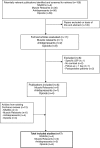A systematic review on the effectiveness of pharmacological interventions for chronic non-specific low-back pain
- PMID: 20680369
- PMCID: PMC3036024
- DOI: 10.1007/s00586-010-1541-4
A systematic review on the effectiveness of pharmacological interventions for chronic non-specific low-back pain
Abstract
The objective of this review was to determine the effectiveness of pharmacological interventions [i.e., non-steroid anti-inflammatory drugs (NSAIDs), muscle relaxants, antidepressants, and opioids] for non-specific chronic low-back pain (LBP). Existing Cochrane reviews for the four interventions were screened for studies fulfilling the inclusion criteria. Then, the literature searches were updated. Only randomized controlled trials on adults (≥18 years) with chronic (≥12 weeks) non-specific LBP and evaluation of at least one of the main clinically relevant outcome measures (pain, functional status, perceived recovery, or return to work) were included. The GRADE approach was used to determine the quality of evidence. A total of 17 randomized controlled trials was included: NSAIDs (n = 4), antidepressants (n = 5), and opioids (n = 8). No studies were found for muscle relaxants; 14 studies had a low risk of bias. The studies only reported effects on the short term (<3 months). The overall quality of the evidence was low. NSAIDs and opioids seem to lead to a somewhat higher relief in pain on the short term, as compared to placebo, in patients with non-specific chronic low back pain; opioids seem to have a small effect in improving function for a selection of patients who responded with an exacerbation of their symptoms after stopping their medication. However, both types of medication show more adverse effects than placebo. There seems to be no difference in effect between antidepressants and placebo in patients with non-specific chronic LBP.
Figures
References
Publication types
MeSH terms
Substances
LinkOut - more resources
Full Text Sources
Medical
Miscellaneous


